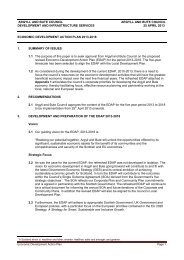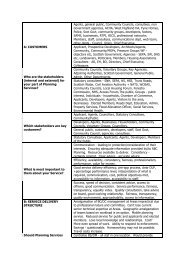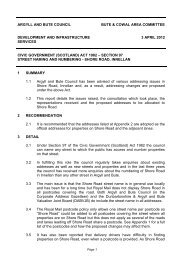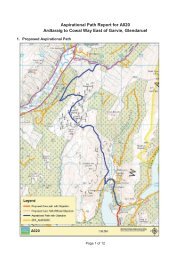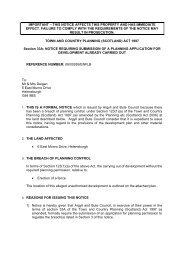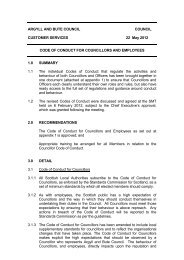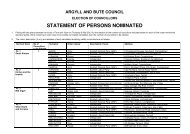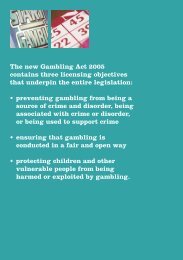Children Missing from Education - Argyll and Bute Council
Children Missing from Education - Argyll and Bute Council
Children Missing from Education - Argyll and Bute Council
You also want an ePaper? Increase the reach of your titles
YUMPU automatically turns print PDFs into web optimized ePapers that Google loves.
<strong>Education</strong> Management Circular No 3.17<br />
Community Services: <strong>Education</strong><br />
<strong>Argyll</strong> House<br />
Alex<strong>and</strong>ra Parade<br />
Dunoon PA23 8AJ<br />
To: Heads of all <strong>Education</strong>al Establishments<br />
Dear Colleague<br />
<strong>Children</strong> missing <strong>from</strong> education (Scotl<strong>and</strong>)<br />
1 Introduction<br />
The Scottish Executive's Vision for Scotl<strong>and</strong>'s <strong>Children</strong> states that in order to<br />
become successful learners, confident individuals, effective contributors <strong>and</strong><br />
responsible citizens, all Scotl<strong>and</strong>'s children <strong>and</strong> young people need to be nurtured,<br />
safe, active, healthy, achieving, included, respected <strong>and</strong> responsible.<br />
To support this vision the Executive has embarked on a major initiative to ensure<br />
that Scotl<strong>and</strong>'s children <strong>and</strong> young people are afforded maximum protection by all<br />
professional services <strong>and</strong> agencies. To promote effective practice in child safety for<br />
education staff, the Scottish Executive has produced the folder Safe <strong>and</strong> Well.<br />
Included in this folder is information on the issue of children missing <strong>from</strong><br />
education.<br />
The purpose of this education management circular is to emphasise the responsibility<br />
of staff in schools <strong>and</strong> other establishments in the matter of missing children <strong>and</strong> to<br />
describe the procedures for dealing with it. The circular should be read in<br />
conjunction with the guidance on <strong>Children</strong> <strong>Missing</strong> <strong>from</strong> <strong>Education</strong> within the Safe<br />
<strong>and</strong> Well H<strong>and</strong>book.<br />
2 Who are children missing <strong>from</strong> education?<br />
<strong>Children</strong> 'missing <strong>from</strong> education' (CME) are children <strong>and</strong> young people of<br />
compulsory school age who are not on a school roll <strong>and</strong> are not being educated<br />
otherwise, ie at home, privately or in an alternative provision. They have usually not<br />
attended school for a substantial period of time (usually agreed at 4 weeks, or<br />
considerably less for more vulnerable children).<br />
<strong>Education</strong> Management Circular 3.17 (Issued 2010) 1
Consequently children missing <strong>from</strong> education:<br />
• may be in need of help or support but are unable to access it; children not in<br />
school may not have had their needs identified <strong>and</strong> there may be no-one actively<br />
connecting them to services;<br />
• may be missing important experiences <strong>and</strong> opportunities to gain knowledge <strong>and</strong><br />
skills; schools provide more than subjects; they provide social opportunities,<br />
practical skills <strong>and</strong> practice for life;<br />
• may be isolated <strong>from</strong> other children <strong>and</strong> adults who can help them.<br />
3 The role of the school<br />
Effective practice to prevent children <strong>from</strong> becoming missing <strong>from</strong> education<br />
involves both pro-active <strong>and</strong> reactive procedures. In the first instance, schools must<br />
ensure that all necessary information is received when a pupil transfers into an<br />
establishment <strong>and</strong> conversely must ensure that all necessary information is passed on<br />
when a child or young person transfers out of their establishment. Where a child<br />
does not attend school <strong>and</strong> is deemed 'missing', then schools must follow the set<br />
authority procedures; see below.<br />
<strong>Children</strong> who are transferring between schools<br />
<strong>Children</strong> <strong>and</strong> young people may transfer school for a variety of reasons such as<br />
families moving house, parental choice etc. For most families these are planned<br />
events <strong>and</strong> information should be gathered regarding the proposed change to ensure:<br />
• the child's smooth transition to his/her new school;<br />
• transfer of the child's or young person's progress record.<br />
Head teachers/campus principals should ensure that the child or young person<br />
progress record is received within 2 weeks of transfer.<br />
The attached Pupil transfer form in appendix 1 may be a useful tool in tracking a<br />
child's transfer especially in the minority of cases where families have a history of<br />
regular school/house/area moves.<br />
If a child transfers into a school with incomplete information <strong>and</strong>, despite enquiries,<br />
this is still unattainable, the Information tracing request form in appendix 2 should<br />
be completed <strong>and</strong> forwarded to your nominated authority CME contact.<br />
<strong>Children</strong> who have become missing <strong>from</strong> education<br />
<strong>Children</strong> <strong>and</strong> young people can be missing <strong>from</strong> education for a variety of reasons,<br />
eg families fleeing <strong>from</strong> domestic violence/abuse, families who have become<br />
homeless. In all cases it is therefore vital that contact is re-established as soon as<br />
possible. Effective procedures to support this are:<br />
<strong>Education</strong> Management Circular 3.17 (Issued 2010) 2
(a) Diligent monitoring of absence in accordance with the authority guidance<br />
contained in education management circular 3.03 School attendance <strong>and</strong> absence<br />
<strong>and</strong> Paper 4, School Attendance, within Section J of Supporting <strong>Children</strong>,<br />
Supporting Effective Learning.<br />
(b) Timeous contact with the authority's designated CME contact. Request for<br />
national search form in appendix 3 should be completed following the steps<br />
outlined in the Local search checklist in appendix 4 <strong>and</strong> e-mailed to the authority<br />
CME contact.<br />
3 The role of the education authority<br />
<strong>Children</strong> have a right to education <strong>and</strong> the authority has a duty to provide education<br />
for all children in its area <strong>and</strong> to plan <strong>and</strong> provide support for vulnerable children. It<br />
is therefore essential that the authority strives to maintain contact <strong>and</strong> trace children<br />
missing education whenever necessary.<br />
The authority will:<br />
(a) ensure establishments are informed of the authority designated CME contact;<br />
(b) assist schools in accessing detailed pupil information;<br />
(c) liaise with schools to undertake local searches for children missing through Click<br />
& Go management information system, records of children educated at home<br />
<strong>and</strong> designated contacts within housing <strong>and</strong> social work;<br />
(d) undertake national searches as necessary through CME (Scotl<strong>and</strong>);<br />
(e) maintain recording system of children missing <strong>from</strong> education <strong>and</strong> progress of<br />
searches; this system acts as a 'virtual school' list <strong>and</strong> allows head<br />
teachers/campus principals to record the missing child as 'left' on Click & Go;<br />
(f) feedback outcome of searches to head teachers/campus principals.<br />
When a CME request is received by the authority CME contact, the following<br />
administrative procedures will be followed.<br />
Following notification <strong>from</strong> an authority school/establishment of a child or young<br />
person missing <strong>from</strong> education:<br />
• a record will be created in the central database;<br />
• a referral form will be e-mailed to the referring school for completion by the<br />
head teacher/campus principal;<br />
• the central database will be updated in light of information contained in the<br />
completed referral form;<br />
• a search of other authority schools/establishments is undertaken by school<br />
support (<strong>Argyll</strong> House);<br />
<strong>Education</strong> Management Circular 3.17 (Issued 2010) 3
• contacts in social work <strong>and</strong> housing are requested to undertake a search of their<br />
management information systems;<br />
• if the child cannot be traced by school support, social work or housing, the<br />
referral will be passed to the <strong>Children</strong> <strong>Missing</strong> <strong>from</strong> <strong>Education</strong> Scotl<strong>and</strong> Service<br />
who will conduct a national search.<br />
4 The role of <strong>Children</strong> <strong>Missing</strong> <strong>from</strong> <strong>Education</strong> Scotl<strong>and</strong> Service<br />
CME Scotl<strong>and</strong> are part of a national project <strong>and</strong> consist of a small team of staff who<br />
liaise with local authorities <strong>and</strong> independent school staff to:<br />
• promote the use of systematic procedures in schools <strong>and</strong> education;<br />
• provide support to develop effective practice in responding to children who<br />
become missing <strong>from</strong> education<br />
• promote consistent practice to locate <strong>and</strong> re-engage children;<br />
• co-ordinate searches across authorities <strong>and</strong> borders;<br />
• support with information transfer;<br />
• provide a national picture of pupil mobility;<br />
• establish close links with other agencies.<br />
The authority will contact CME Scotl<strong>and</strong> when a search for a child or young person<br />
missing <strong>from</strong> education within the local authority area has provided no results.<br />
When a response has been received <strong>from</strong> CME Scotl<strong>and</strong>, the outcome will be passed<br />
to the original referrer.<br />
It is essential that all CME Scotl<strong>and</strong> search requests are administered centrally<br />
through school support. Schools are instructed not to contact CME Scotl<strong>and</strong> directly<br />
with a referral.<br />
5 Follow-up procedures<br />
When the whereabouts of a child missing education is identified within the authority<br />
boundaries, every effort will be taken to support the child's return to school. If it is<br />
established that a child has not been enrolled in a school in his/her appropriate<br />
catchment area the authority will:<br />
• request the attendance officer to undertake a home visit;<br />
• contact the parent /carer to establish if a placing request is required;<br />
• offer guidance in respect of clothing grants, free school meal entitlement <strong>and</strong><br />
transport.<br />
<strong>Education</strong> Management Circular 3.17 (Issued 2010) 4
6 Useful contacts<br />
Authority CME contact<br />
School support<br />
Mr Chris Shirley, Quality St<strong>and</strong>ards Manager<br />
<strong>Argyll</strong> House, Alex<strong>and</strong>ra Parade, Dunoon PA23 8AJ<br />
Telephone 01369 708528<br />
Ms Maggie McLay<br />
<strong>Argyll</strong> House, Alex<strong>and</strong>ra Parade, Dunoon PA23 8AJ<br />
Telephone 01369 708508<br />
7 Publications<br />
Safe And Well - a h<strong>and</strong>book for staff, schools <strong>and</strong> education authorities, Scottish<br />
Executive (2005)<br />
Child Protection Guidelines in Supporting <strong>Children</strong>: Supporting Effective Learning,<br />
Section G, <strong>Argyll</strong> <strong>and</strong> <strong>Bute</strong> <strong>Council</strong> (2007)<br />
Yours sincerely<br />
Executive Director of Community Services<br />
March 2010<br />
<strong>Education</strong> Management Circular 3.17 (Issued 2010) 5
Appendix 1: Child <strong>and</strong> young person transfer form<br />
Current school details<br />
School name<br />
Stage/class<br />
Child or young person details<br />
Name DoB Gender<br />
Current address<br />
Telephone number<br />
Destination home<br />
Address<br />
Mobile number<br />
Destination school<br />
Name <strong>and</strong> address<br />
of school<br />
Telephone number<br />
Telephone number<br />
Interim contact details (eg relative)<br />
Name<br />
Address<br />
Telephone number<br />
Parent/carer signature<br />
Date<br />
Head Teacher/campus<br />
principal signature<br />
Date<br />
Child or young<br />
person record sent<br />
Address sent to<br />
Y / N Date If no give reason<br />
Receipt of delivery Y / N Date<br />
Signed<br />
Designation<br />
<strong>Education</strong> Management Circular 3.17 (Issued 2010) 6
Appendix 2: Information tracing request form - children arriving at school<br />
Personal details<br />
Full name DoB Gender<br />
Name known as<br />
Current address<br />
UPI<br />
Telephone number<br />
Other family names<br />
Mobile number<br />
Details given/known<br />
Child protection register Y / N Traveller family Y / N<br />
Additional support needs Y / N Educated at home Y / N<br />
Child protection investigation Y / N History of exclusions Y / N<br />
Looked after child Y / N Medical issues Y / N<br />
Cultural issues Y / N History of long holidays Y / N<br />
Previous school<br />
Other agency involvement<br />
(past <strong>and</strong> present)<br />
Other information/concerns<br />
Schools details<br />
School to be enrolled into<br />
Date<br />
Details of referrer<br />
Name<br />
Organisation/<br />
local authority<br />
Date<br />
Contact telephone<br />
Designation<br />
Email<br />
<strong>Education</strong> Management Circular 3.17 (Issued 2010) 7
Appendix 3 - Request for national search: <strong>Children</strong> <strong>Missing</strong> <strong>from</strong> <strong>Education</strong><br />
(Scotl<strong>and</strong>)<br />
Personal details<br />
Full name DoB Gender M / F<br />
Siblings<br />
1<br />
2<br />
3<br />
4<br />
SCN (Scotl<strong>and</strong>)<br />
Last known<br />
address<br />
UPI (outside Scotl<strong>and</strong>)<br />
Ethnic background<br />
Telephone number<br />
Other family<br />
names<br />
Mother's first <strong>and</strong> maiden name (if known)<br />
Father's name<br />
Other known family whereabouts <strong>and</strong><br />
telephone number(s)<br />
Mobile number(s)<br />
DoB<br />
DoB<br />
Emergency<br />
contact<br />
Tel no<br />
School details<br />
Last school attended (inc<br />
SEED or school code)<br />
Year group/class<br />
Date of enrolment<br />
Name of head<br />
teacher/campus principal<br />
Other schools attended <strong>and</strong><br />
dates<br />
Date of last day<br />
<strong>Education</strong> Management Circular 3.17 (Issued 2010) 8
Further details<br />
Child protection register Y / N Traveller family Y / N<br />
Child protection investigation Y / N Educated at home Y / N<br />
Additional support needs Y / N History of exclusions Y / N<br />
Looked after child Y / N Medical issues Y / N<br />
Cultural issues Y / N History of long holidays Y / N<br />
History of erratic attendance Y / N<br />
Explain details answered 'Y' <strong>and</strong> any other related concern<br />
Details of local investigation including other agencies involved with child/family<br />
Date of local investigation<br />
Details of referrer to local authority designated officer<br />
Name<br />
Designation<br />
School<br />
Contact telephone<br />
Email<br />
CME (Scotl<strong>and</strong>) will usually contact this person for further information<br />
Details of local authority designated officer<br />
Name<br />
Designation<br />
Local authority<br />
Contact telephone<br />
Date<br />
Email<br />
<strong>Education</strong> authority designated officers send to:<br />
<strong>Children</strong> <strong>Missing</strong> <strong>from</strong> <strong>Education</strong> (Scotl<strong>and</strong>), Scottish Government, Support for Learning Division, Victoria Quay,<br />
Edinburgh EH6 6QQ<br />
Telephone 0131-244 1510; fax 0131-244 7943; email cmescotl<strong>and</strong>@scotl<strong>and</strong>.gsi.gov.uk<br />
<strong>Education</strong> Management Circular 3.17 (Issued 2010) 9
Guidance notes for completing request form for national search<br />
1 Prior to completing the application form the following must be checked:<br />
• a home visit has concluded that the child is not there;<br />
• friends/relatives have been asked;<br />
• other schools in the local authority confirm the child has not transferred;<br />
• the housing department confirm that the family have left/been evicted/ been rehoused;<br />
See CME (Scotl<strong>and</strong>) guidelines within Safe <strong>and</strong> Well for a more extensive list of<br />
actions prior to referral.<br />
2 The form should have full <strong>and</strong> accurate details. Incomplete forms may be returned<br />
to the referrer.<br />
3 H<strong>and</strong> written forms should be legible <strong>and</strong> completed in black ink.<br />
4 <strong>Children</strong> withdrawn for home education should only be referred if they are on the<br />
child protection register or there has been a child protection investigation carried out<br />
or pending.<br />
5 Gypsy/traveller children should only be referred if there are care <strong>and</strong> welfare or child<br />
protection concerns. See guidance issued by CME (Scotl<strong>and</strong>).<br />
6 Other agencies involved with the child have been checked for information <strong>and</strong> such<br />
information included in this form.<br />
7 Staff can become concerned about children's safety <strong>and</strong> wellbeing for many reasons,<br />
<strong>from</strong> 'gut feeling' to full disclosure. Staff should follow their instinct <strong>and</strong> take action<br />
if they feel a child may be vulnerable. It is better to refer than not to!<br />
8 CME Scotl<strong>and</strong> will receive referrals after a local search, as early as is considered<br />
necessary by the local authority, depending on their assessment of risk. However, in<br />
all circumstances action should be taken within 20 days of a child being 'missing'<br />
<strong>from</strong> education.<br />
9 If a local authority has information about a specific address in another local authority<br />
there is no need to refer to CME (Scotl<strong>and</strong>) in the first instance. Contact can be<br />
made with the new local authority directly. If the child is not located this way then<br />
referral to CME (Scotl<strong>and</strong>) should be made.<br />
<strong>Education</strong> Management Circular 3.17 (Issued 2010) 10
Appendix 4 - Checklist - local search - general guide<br />
√<br />
- tick what you have done<br />
Take care to record all of the steps you take to find a child - the date <strong>and</strong> time, <strong>and</strong><br />
who was involved. Record what happens at each stage <strong>and</strong> encourage staff to put<br />
their 'thinking' on paper about possible leads <strong>and</strong> where to find further information.<br />
This helps continuity if different staff are involved.<br />
Identify a lead person at school level <strong>and</strong> at local authority level to co-ordinate<br />
information <strong>and</strong> recording.<br />
Try to record information in ways that enable you to pass your search information on<br />
to other services to assist with searching in other areas.<br />
Assess the risks <strong>and</strong> vulnerability of the child involved. Use this as a guide to judge<br />
the appropriateness of steps suggested below <strong>and</strong> to set a timescale for each step.<br />
Steps that schools may take<br />
Ask other children in the class/school (consider also confidentiality <strong>and</strong> sensitivity).<br />
Check what other staff know.<br />
Phone home.<br />
Visit home.<br />
Write home (recorded delivery).<br />
Contact the child's named emergency contacts.<br />
Check with the parents'/carers' employers.<br />
Review records held on the child <strong>and</strong> discuss with support staff/class teacher.<br />
Liaise with other agencies involved with the child/family (health, social work,<br />
voluntary agencies, police)<br />
Steps that authorities may take<br />
Review the record of local search activities.<br />
Clarify local intelligence to identify any other areas in the UK where there may be a<br />
family connection or reason to relocate.<br />
Agree with local staff the level of risk/vulnerability of the child.<br />
Call CME Scotl<strong>and</strong> <strong>and</strong> email all relevant documents/information.<br />
Follow up<br />
Keep a copy of all records until a search provides information on where the child is.<br />
Maintain search records on children who have been found locally or nationally.<br />
<strong>Education</strong> Management Circular 3.17 (Issued 2010) 11
<strong>Children</strong> in mobile or vulnerable families may disappear <strong>from</strong> view again, <strong>and</strong><br />
information <strong>from</strong> previous searches may be helpful.<br />
As with all children <strong>and</strong> young people's records, keep data safely <strong>and</strong> confidentially.<br />
Remember<br />
If a child goes missing before a school holiday, if it is not known that a family<br />
holiday was planned, <strong>and</strong> there is a level of concern for the child, it is important that<br />
the search process is continued during the holiday.<br />
Staff who have built up a relationship with children or their families are a key<br />
resource in seeking families; they may be staff <strong>from</strong> any service in the community.<br />
These staff may not have the time to co-ordinate a local search, but their insight is<br />
invaluable <strong>and</strong> should be used.<br />
<strong>Education</strong> Management Circular 3.17 (Issued 2010) 12



